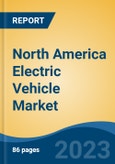Speak directly to the analyst to clarify any post sales queries you may have.
10% Free customizationThis report comes with 10% free customization, enabling you to add data that meets your specific business needs.
Their low-to-zero fossil fuel consumption, lesser moving parts that require maintenance, and low running costs, make electric vehicles eco-friendly. The government is also promoting policies to reach the goal of net-zero emission targets. North America has set up a goal of selling half of all new vehicles sold to be electric by the year 2030 and by providing a network of 500,000+ charging stations nationwide by 2030. The market for electric vehicles has expanded in part because of the awareness campaigns that have been launched to encourage the usage of these vehicles, as well as the rise in the number of factories that make them. Low-emission technology used in electric vehicles aids in reducing greenhouse gas emissions and addressing other environmental problems.
A massive economic downturn has been brought on by the COVID-19 pandemic outbreak. Strict lockdowns were implemented in several nations to control the virus; as a result, manufacturing industries were shut down, supply networks were disrupted, and production schedules were thrown off. The North American market suffered considerable devastation during COVID-19, resulting in reduced production and sales of electric vehicles in the region.
Increasing Investments in the EV Ecosystem
Electric vehicles produce less carbon emission as compared to diesel and petrol vehicles. Thus, electric vehicles are replacing gasoline-powered vehicles quickly in North America's automotive industry. EV car sales annually are currently at 4% in the USA, rising to around 50% in 2030 in the USA. With more than 12,000 locations to charge, including fast charging, and more than 35,000 charge plugs - more than any other automaker - Ford is providing its all-electric vehicle customers with North America's largest electric vehicle public charging network, addressing a major concern for those switching to all-electric cars. So, many businesses around the world are making significant investments to advance the decarbonization of transportation and equipment and enhance urban air quality. Demand for EVs is being driven by the rising adoption of electric vehicles to reduce emissions, pollution, and carbon footprints, as well as increased public knowledge of the benefits of using electric vehicles to accomplish so. Stricter government emissions restrictions are also fueling the market for EVs.Developing advanced technology in Electric Vehicle
Smart charging for electric vehicles is gaining popularity as it enables users to regulate the time and rate of charge in response to energy demand, balancing the grid. The next stage, however, is vehicle-to-grid (V2G) charging, which enables energy stored in the battery of the vehicle to be exported to the grid at times of high demand. Wireless EV charging is also gaining momentum as a number of manufacturers coordinate their integration with technology vendors. BMW was the industry's first pioneer, introducing factory-installed wireless charging equipment prior to a drop in the volume of sales. Recently, models with wireless charging capabilities have been unveiled by Hyundai, FAW, and IM Motor. Additionally, vehicle OEMs like Volvo, Jaguar, and Renault, as well as Tier 1 suppliers like Siemens, Mahle, and Magna, are investing in this sector.E-Mobility Infrastructure and Range Concern
One of the major challenges in the adoption of electric vehicles is the range of the vehicle and charging stations. Many OEMs are building the charging station so the consumer has access to efficient charging along the way. Also, the consumers are concerned about the charging time and range between the stoppage of the vehicle and more long charging time to charge the vehicle.Market Segmentation
The North America, Electric Vehicle Market, is segmented by vehicle type, propulsion type, range, battery capacity, and by region. Based on vehicle type, the market is segmented into Two-wheeler, Passenger Car, Light Commercial Vehicle, Medium & Heavy Commercial Vehicle, and OTR. Based on propulsion type, the market is segmented into BEV, PHEV, and FCEV. Based on range, the market is divided into 0-50 Miles, 51-150 Miles, 151-200 Miles, 201-400 Miles, and Above 400 Miles. Based on battery capacity, the market is segmented into less Than 50 kWh, 51 kWh to 100 kWh, 101 kWh to 200 kWh, 201 kWh to 300 kWh, and Above 300 kWh.Company Profiles
Tesla, Inc., BMW Group, BYD Company Ltd., Volkswagen AG, Hyundai Motor Company, AB Volvo, Daimler AG, Ford Motor Company, General Motors Company, and Honda Motor Co., Ltd. are the key players developing advanced technologies to stay competitive in the market and enhancing their product portfolio in the regions to increase their customer outreach.Report Scope:
In this report, North America Electric Vehicle Market has been segmented into the following categories, in addition to the industry trends, which have also been detailed below:North America Electric Vehicle Market, By Vehicle Type:
- Two-Wheeler
- Passenger Car
- Light Commercial Vehicle
- Medium & Heavy Commercial Vehicle
- OTR
North America Electric Vehicle Market, By Propulsion Type:
- BEV
- PHEV
- FCEV
North America Electric Vehicle Market, By Range:
- 0-50 Miles,
- 51-150 Miles
- 151-200 Miles
- 201-400 Miles
- Above 400 Miles
North America Electric Vehicle Market, By Battery Capacity:
- less Than 50 kWh,
- 51 kWh to 100 kWh,
- 101 kWh to 200 kWh,
- 201 kWh to 300 kWh,
- Above 300 kWh
North America Electric Vehicle Market, By Country:
- United States
- Canada
- Mexico
Competitive Landscape
Company Profiles: Detailed analysis of the major companies present in North America Electric Vehicle Market.Available Customizations:
With the given market data, the publisher offers customizations according to a company’s specific needs.This product will be delivered within 1-3 business days.
Table of Contents
Companies Mentioned
- Tesla, Inc.
- BMW Group
- BYD Company Ltd.
- Volkswagen AG
- Hyundai Motor Company
- AB Volvo
- Daimler AG
- Ford Motor Company
- General Motors Company
- Honda Motor Co., Ltd








